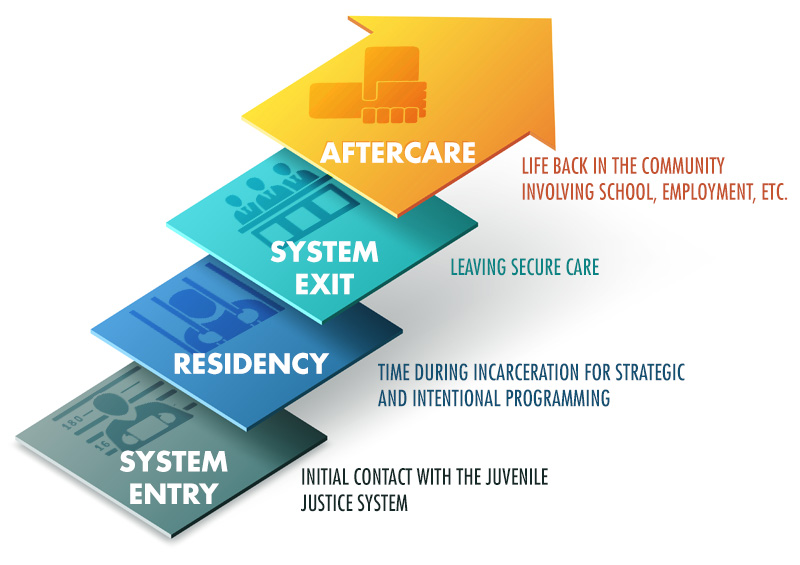What is transition planning and why is it important?
Page 2: Overview of Transition Planning
Glossary
Transition: Each move during the youth’s contact with the juvenile justice system, including placement changes and exiting the system.
Reentry: Exiting the system and rejoining the community (e.g., returning to school, finding employment); becoming reintegrated as a productive citizen.
Recidivism: The tendency of an individual to be adjudicated and reincarcerated for new acts of delinquent or criminal behavior.
Aftercare: Community-based services that help incarcerated youth make the transition to the home environment.
When they become involved in the juvenile justice system, incarcerated youth go through a number of transitions. These include entering the facility, frequently moving within and between facilities, and finally returning to the community. The graphic below illustrates the various transitions made by incarcerated youth.

Like Carlos, the young man you met in the Challenge, almost all incarcerated youth will one day be released into the community. However, transition and reentry can be difficult for youth dealing with issues that include:
- Negative peer influences
- Unsafe or unsupervised home environments
- Schools that are not welcoming
- Lack of access to needed behavioral and mental health services
- The presence of a disability
These issues might have contributed to their incarceration in the first place and, if not addressed, might lead to recidivism. It takes time and effort to address these challenges adequately and to help youth learn appropriate, adaptive behaviors (e.g., social skills). This can be done through effective transition planning, a process that guides all transition-related activities in the JC setting. A related term, secondary transition planning, refers to the process of helping a student with a disability make the transition from high school into the community or an adult education setting. Ideally, when teachers work with youth with disabilities, these two transition plans should inform each other and enhance the continuity of services and supports. Transition planning should begin as soon as a youth arrives at a juvenile corrections facility, a practice referred to as “exit at entry,” and be carried out by a multidisciplinary transition or reintegration team consisting of professionals from within (e.g., parole officer) and without the juvenile justice system (e.g., foster care services) as well as other interested parties (e.g., parents or guardians). The transition team utilizes collaboration between agencies to create and implement the transition plan. Transition planning should address three areas:
![]()
Research Shows
- An effective transition process combined with high-quality support services are crucial if a youth is to successfully reenter the community. It is also critical that the transition process begin as soon as a youth enters the juvenile justice system.
(Griller Clark, Mathur, Brock, O’Cummings, & Milligan, 2016) - Youth with disabilities are more likely to be re-incarcerated than are their non-disabled peers. They also struggle more to be successful at school and in the workplace.
(Griller-Clark & Unruh, 2010; Zhang, Barrett, Katsiyannis, & Yoon, 2011) - At a 12-month follow-up, youth with disabilities who received appropriate transition services, including educational supports, were three times more likely to have remained in the community without further involvement with the justice system.
(Bullis, Yovanoff, Mueller, & Havel, 2002)
Listen as Sarup Mathur and Heather Griller Clark, both of Project RISE—a project focused on successful reentries for youth released from juvenile corrections facilities—discuss the importance of planning for youth to transition back into the community.

Sarup Mathur, PhD
Co-Principal Investigator, Project RISE,
Mary Lou Fulton Teachers College
Arizona State University
(time: 2:46)

Heather Griller Clark, PhD
Co-Principal Investigator, Project RISE,
Mary Lou Fulton Teachers College
Arizona State University
(time: 2:12)
Transcript: Sarup Mathers, PhD
These kids have to go back to the community. We have to prepare them for reentry. It should begin from the day that they actually enter the facility. The purpose is to actually prepare them to be able to get out with some skills and competency so that they’re successful when they’re back in the community. However, in my experience in working in this area, we noticed that our focus stayed within the facility for a very long period of time, and we sort of hoped that the youth would get out, would know how to actually navigate the system, and would be able to enter successfully within the community and be able to perform as a great citizen. We all know that our systems are pretty tough to navigate, so how can we actually expect that the kid or the youth, who is 15 years of age, would be able to navigate through this by herself or himself? So I think it’s important that we begin to understand their issues and start the programming from day one.
The other thing we learned from our experience is that we never incorporated youth wants in planning and programming for reentry. We assumed that the facility needs to have cognitive restructuring. We need to have anger management. We need to have substance-abuse supports, which is essential. But at the same time we never could understand the nature of the barriers that these youth actually experience and how some of these things could assist them. So now we have started to utilize that component in the planning process. We have started to focus upon what they are telling us.
And we figured it was important for us to find out about the capacity of the stakeholders—for example, the community colleges, schools, unemployment agencies, Goodwill—in their knowledge and their preparation about reentry. And we found that many of our stakeholders indicated their lack of knowledge about reentry practices, and we felt that their lack of knowledge about these reentry practices serves as a barrier for youth who actually gets out and tries to navigate these systems. Now we have started to build capacity of our stakeholders, and we’re trying to increase their awareness and their knowledge base. So I think it’s extremely important that the planning and programming actually starts for this youth as soon as the kid actually gets into the facility.
Transcript: Heather Griller Clark, PhD
I think transition planning for kids in juvenile justice settings, especially those with disabilities, is extremely important, because we want to prepare them for their reentry into the community. And that transition planning should begin day one, the first day that they’re in the facility. And there are a number of things that can be done early on, including records requests, orienting the student to the facility, setting the stage for what their time is going to look like, and really beginning that transition conversation with some good diagnostics, some vocational inventories and skill assessments, perhaps a credit analysis. Really the dialogue about transition and what that individual wants to do once they’re released needs to begin right away.
It’s vitally important because it prepares them for this reentry. We all want our youth to be successful. We want facilities to do what they were intended to do, which is address any treatment issues, whether that be substances or anger-management, and then we want to get those individuals back into the community in a productive way. And if we don’t invest in transition and supporting those activities both behind the fence and once the individual’s released then we’re really doing society in general a disservice, because we’re not preparing those kids for that reentry. We’re not preparing them to be successful members of society, and the cost of incarceration is tremendous. So we’re not doing a service to the public and tax payer dollars as well if we don’t focus on transition.
Throughout this module, you will learn more about the transition process for incarcerated youth. This will include the implementation of research-based practices, listed below, that can improve the outcomes for this population. For a quick overview, click on each of the purple tiles below. On subsequent pages, these practices will be discussed in more detail within the context of the transition process.
Information adapted from NDTAC’s Transition Toolkit 3.0.
Note: In the United States, each state has its own juvenile justice (JJ) system. Although there are many similarities among these systems, there are also substantial differences in their policies and procedures. Viewers of this module are encouraged to become familiar with the policies and procedures of their local JJ system in order to provide the most beneficial transition services.
For Your Information
 In addition to receiving funds from state and local agencies to help support transition programs, juvenile corrections facilities may be eligible for federal funds. Juvenile corrections facilities must determine whether they meet the funding criteria for each source before applying. These federal funding sources include:
In addition to receiving funds from state and local agencies to help support transition programs, juvenile corrections facilities may be eligible for federal funds. Juvenile corrections facilities must determine whether they meet the funding criteria for each source before applying. These federal funding sources include:

This toolbox lists and describes additional resources related to the information presented in this module. These resources are provided for informational purposes only for those who wish to learn more about the topic(s). It is not necessary for those viewing this module to read or refer to all of these additional resources to understand the content. For more information about the instructional challenges frequently encountered by teachers in juvenile corrections settings and ways to address these challenges, including key instructional and behavioral foundations and recommendations for working with students with disabilities, please visit the IRIS Module: For more information about the secondary transition process for students with disabilities in educational settings and about interagency collaboration, please visit the IRIS Modules:
To learn more about identifying and selecting an EBP, implementing it with fidelity, and evaluating its effectiveness for a given youth, visit the following IRIS Modules:
Additionally, the Neglected or Delinquent Technical Assistance Center for the Education of Children/Youth Who Are Neglected or At-Risk (NDTAC) offers resources about the transition process for youth in the juvenile justice system. In particular, the Transition Toolkit provides useful information that helps teachers and service providers provide transition services for incarcerated youth. |